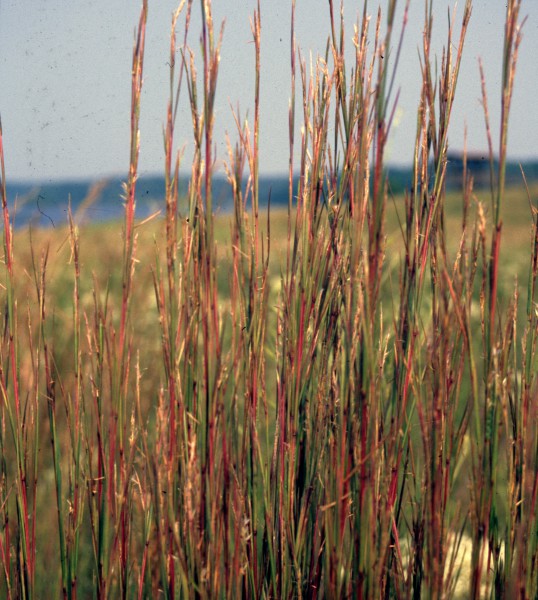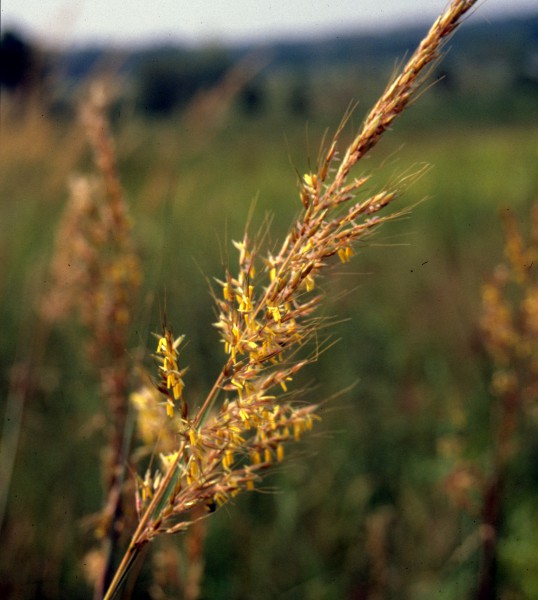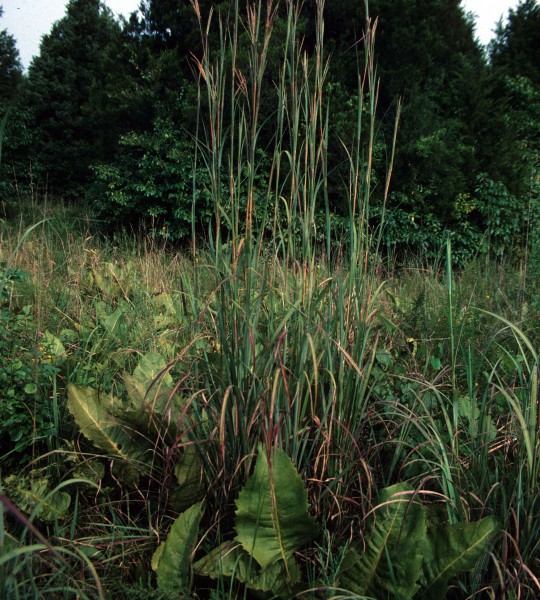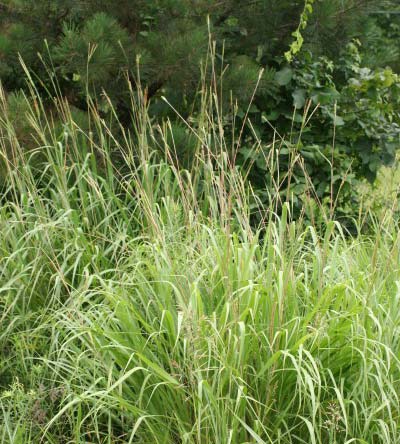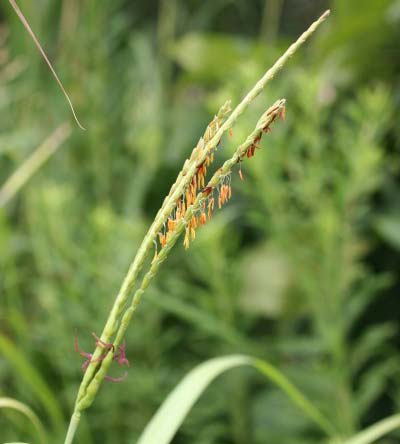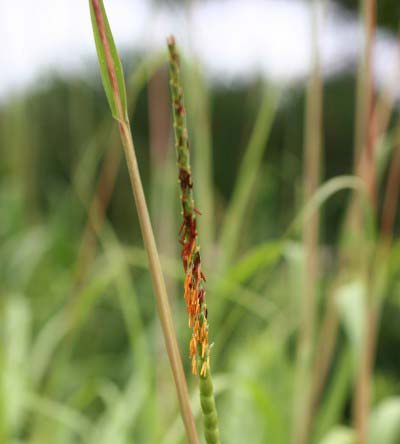Benefits of Native Warm-Season Grasses
By Marina D'Abreau Denny, Extension Associate
Published 4/29/13
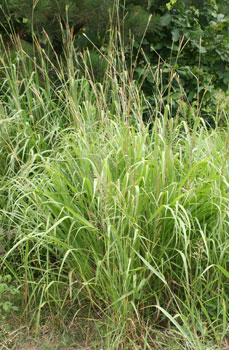
Photo by Dr. Jeanne Jones
Mississippi is home to a variety of native warm-season grasses, legumes, and forbs. Together, they make up the foundation of grassland ecosystems, an important habitat for a variety of wildlife including bobwhite quail, grassland songbirds, cottontail rabbits, and many small mammals and reptiles.
Benefits of native warm-season grasses, legumes, and forbs include the following:
- wildlife habitat, including food and cover sources
- soil stabilization and erosion control
- vegetative filtration of sediments and chemicals from agricultural lands
- pasture or hay for livestock forage
- ornamental landscaping
- restoration of ecosystems
Warm-season grasses are known for their high drought and heat tolerance, good wear recovery, and excellent disease resistance.
Native Grasses Provide Wildlife Habitat
When interspersed with native forbs, legumes, and patches of thickets, native warm-season grasses can provide excellent cover for grassland wildlife, which is essential for reproduction, brood rearing, and escape from predators.
Grassland habitats are especially beneficial to insects (i.e., butterflies) and young quail, because the growth form of these grasses offers open space at ground level, which provides opportunities for forbs to grow and for small wildlife to move freely. Many species of insects also will utilize the grass stems during larval stages.
Recommendation: If your primary goal is to provide habitat for wildlife, the recommended combination is a stand of 30 to 50% native grasses, 5% to 10% shrubby, woody cover like plum, sumac, or blackberry thickets, and 30% to 40% forbs and legumes, such as ragweed, partridge pea, black-eyed Susan, and beggarweed.
Native Grasses Provide Erosion Control and Vegetative Filtration
The roots of warm-season grasses are thick and go very deep into the soil, making for long lasting, stress tolerant, and low maintenance plants. Their root systems also improve drainage rates and increase absorption of rain. Grasses planted between agricultural fields and streams or ponds help remove nutrients that may otherwise run off into the water and lead to high nutrient levels, algal blooms, and possible fish kills.
Native Grasses Can be Used As Livestock Forage
By growing warm season grasses along with your traditional cool season grasses, you can maintain forage production spring through fall, and even stockpile forage for an extended-season grazing. Keep in mind, though, that not all grasses have the same quality for wildlife habitat or livestock forage. For example, broomsedge provides great nesting habitat for quail, but makes a poor livestock forage. Eastern gamagrass, on the other hand, produces excellent forage for haying and grazing.
Native Grasses Can Be Used in Ornamental Landscaping
The creation of a “mini-prairie” around your home by mixing native grasses and forbs could offer a great spot for a diversity of birds, butterflies, and other small wildlife. Consider designing walking paths in your prairie to provide access to the flowers and grasses.
Some native grasses and forbs to consider in a residential landscape include:
- Big Bluestream - a perennial bunchgrass with blue-green stems 4-8 ft. tall. The seed head resembles a turkey’s foot. Fall color is maroon-tan (perfect for MSU fans!).
- Side-oats Grama - a perennial warm season grass; clump forming. This medium-tall grass (2ft to 3ft stems) mixes well in plantings with spring wildflowers, because it stays short in the spring. Birds love the ripe seeds.
- Switchgrass - Clump-forming grass about 3-6 ft. tall, with a large, open, finely textured, reddish-purple seedhead. Fall color is pale yellow and lasts throughout the winter.
- Partridge-pea - a slender-stemmed, 1-3 ft. annual with small, yellow-green leaflets that fold together when touched. Showy yellow flowers attract bees and butterflies. Seeds are eaten by game birds and songbirds, and the plant provides excellent cover for game birds and browse for deer.
- Mississippi Penstemon - This perennial wildflower produces 2-5 ft. stems topped with stalked clusters of white, tubular flowers from May through July. Bees are attracted to the nectar, guided by purple lines down the throat of flowers.
Other common grasses include little bluestem, broomsedge, Indiangrass, switchgrass and Eatern gammagrass. Common native forbs in Mississippi include beggarweeds, blackeyed Susan, coreopsis, and penstemon.
Native Grasses Help Restore Ecosystems
Native warm-season grasses can help restore prairies, oak woodland savannahs, and pine woodland savannahs. Your first step is to determine if a native warm-season grass and forb community may be already present, but is being suppressed by competition with non- natives or if you need to start from scratch by planting native seeds.
A wildlife biologist or other experienced professional can provide technical advice to determine if a particular site might be restored to a good native plant community through herbicidal treatments. The selectivity of the herbicide and timing of application are critical. Following control of invasive and/or undesirable vegetation, a native plant community may be replanted.
If you plan to plant native grasses from seed, choose cultivars or varieties that originated close to your region of the state, if available, because they may be better adapted to your climate. The recommended planting season is from mid-April to early June, but you can also plant during the dormant season (December through February).
In general, the maximum amount of all grasses planted should be in the range of 3 to 6 pounds of pure live seed (PLS) per acre for wildlife habitat. Sparse stands of grass are more desirable for wildlife because they allow access for species that travel and forage along the ground and allow forbs to establish that produce wildlife food. Forb seeds can be mixed with native grass seeds for plantings. Establishing or protecting scattered patches of native shrubs and trees in pastures restored to native grasses will also enhance your wildlife habitat by increasing cover and food resources.
Non-native Grasses
Non-native grasses, including cogongrass, bahiagrass, johnsongrass, bermudagrass, and tall fescue, are highly competitive and invasive plants that typically degrade wildlife habitat and native plant communities. It is important that landowners make every effort to control the spread of these invasive, non-native plants, while fostering the resurgence of our native flora.
More Information
For more information and details on native warm-season grasses, visit our web page.
References
- DeLong, C. and Brittingham, M. (2002). Warm-Season Grasses and Wildlife. Pennsylvania Wildlife No. 12, The Pennsylvania State University.
- Diboll, N. (n.d.). Designing Natural Landscapes with Native Plants. Prairie Nursery, Westfield, WI, https://www.prairienursery.com
- Hamrick, R., et al. (2007). Native Warm-Season Grass Restoration in Mississippi. Publication 2435, Mississippi State University Extension Service.
- Harper, C., et al. (2007). Native Warm-Season Grasses: Identification, Establishment and Management for Wildlife and Forage Production in the Mid-South. PB 1752, University of Tennessee Extension.
- Harper, C.A., et al. (2004). A Landowner’s Guide to Native Warm-Season Grasses in the Mid-South. PB 1746, University of Tennessee Extension.
- Lady Bird Johnson Wildflower Center, The University of Texas at Austin. https://www.wildflower.org/
- Virginia Department of Game and inland Fisheries. (2013). Native Warm Season Grasses (NWSG).


